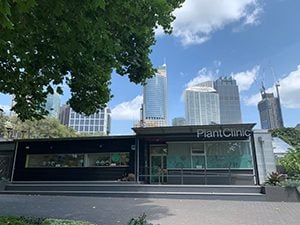PlantClinic houses a small team of plant pathologists – Dr Edward Liew, Manager Plant Pathology, Dr Matt Laurence, Diagnostics and Facilities Co-ordinator, Allison Mertin, PhD student and part-time Technical Officer and occasionally myself. The team is supported by a fantastic array of volunteers who assist with research, maintenance of the labs and collection and the diagnostic jobs needing processing.
The building was recently renovated to open it to the community visiting the Garden – fences removed, landscaping upgraded, and access provided to allow visitors to look into the labs to see research in action. Extensive signage was installed to outline the importance of plant health to society and the impacts that plant diseases can have on humanity. All of this was funded by the Foundation and Friends of the Botanic Garden who have provided fantastic support for the plant health work at the Gardens over more than 30 years.

Located in the Royal Botanic Garden Sydney, PlantClinic houses the Plant Pathology team of the Botanic Gardens and Centennial Parklands.

Extensive signage is installed outside PlantClinic to outline the importance of plant health to society and the impacts that plant diseases can have on humanity.
Within PlantClinic there are two major activities underway – research into plant health issues and the diagnostic program known as the Plant Disease Diagnostic Unit. Our research program focuses on a range of diseases and disease-causing organisms, especially those causing issues in amenity horticulture and natural ecosystems. Examples include mapping the extent of Phytophthora in national parks in New South Wales and the impact of the disease on threatened species including the Wollemi pine. The team provides support for identification of a range of pathogens, especially Phytophthora and Fusarium species, for many researchers across the country, and internationally.
The Plant Disease Diagnostic Unit focus is on the diagnosis of plant disease issues both for the Gardens and Parks in our organisation and as a fee for service operation for gardeners and land managers (amenity and natural ecosystems). With nearly 50,000 different species of plants grown across our sites this is no easy task and there are many new diseases and pests arising frequently, as might be expected with the diversity of species, landscapes and climates that exist at our sites.
The nature of the diseases that are diagnosed are variable but generally focus on soilborne diseases, especially Phytophthora and Armillaria root rot, wilt diseases, and foliar and flower pathogens. In our tree population, cankers and rots in the base of trees or in branches are a key concern given the potential for these problems to cause weaknesses and potential failures where branches or whole trees may collapse. When you have 5 million visitors each year you cannot afford to let this happen.
Diagnosis is based on a combination of traditional observation and culturing organisms to identify them. Soilborne pathogens like Phytophthora are baited from soil samples with lupins seedlings to stimulate the pathogens zoospores to germinate and grow. But, on top of all of this, there is an increasing reliance on specialised DNA based molecular tools to facilitate rapid and accurate identification of the pathogen. In the future, these tools will become more and more important, not just with human disease like COVID-19 but in all areas of disease diagnostics,
For more information, visit the PlantClinic website.

One comment, add yours.
Ann Bottrell
Can you assist with identifying whether my tree has been poisoned? Half of it has died and I have found drill holes? My Number is 0409633278